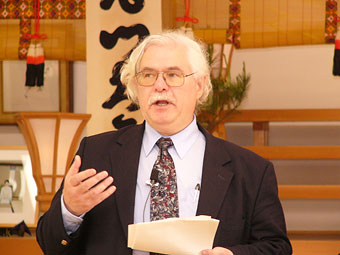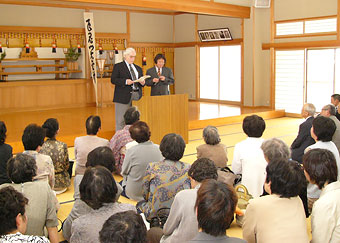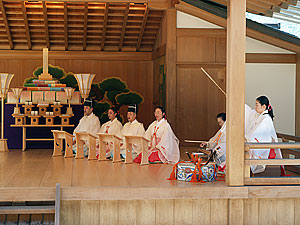
By Bill Roberts
Bill Roberts delivered the following speech at Oomoto Izumo Branch on Sunday, May 15, 2005
Konichiwa. Bill Roberts des. Yoroshiku. Onegaishimasu.
It is an honor to speak today at your tsukinamisai. I think Izumo is the twelfth Oomoto branch I have visited and the eighth branch to ask me to speak.
As you might know, the Oomoto Foundation has commissioned me to write a book about Oomoto in English for non-Japanese readers, especially the artists, interfaith activists and peace seekers who are increasingly attracted to Oomoto.
I have been here since October working on it and will be here for another six months.

Of course, in my book I write about Onisburo Deguchi. In fact, I have recently been working on some of the chapters about him.
Given the importance of Izumo to Onisaburo, I thought Oomoto followers here might be interested to hear how someone from the West views Onisaburo Deguchi.
In writing this book I am always looking for analogies to help Western readers understand Oomoto. So I have been thinking about notable people in the West who compare in some way with Onisaburo.
A few months ago I interviewed Kyotaro Deguchi and asked him which Western figure or figures reminded him of his grandfather. Kyotaro said he needed time to think about it.
A month later I received a typed, single-spaced three-page letter listing more than twenty names, mostly Americans, who reminded Kyotaro of some trait of Onisaburo.

I did not agree entirely with all the names on his list, but I do agree with his notion that there is no one person in the West like Onisaburo.
Kyotaro called his grandfather “a maelstrom of characters. Few people understand the whole.” I would definitely agree with him on that point.
When I look at the life of Onisaburo Deguchi I see a poet, a potter, a political gadfly and, most importantly, a prophet.
As a writer, Onisaburo was as prolific and humorous as the American Mark Twain, and had a social conscience like Charles Dickens, the nineteenth century British novelist whose works included “Oliver Twist” and “David Copperfield.”
However, his magnum opus, the eighty-three volume Reikai Monogatari, often reads like Dante, the fifteenth century Italian writer whose, “Divine Comedy,” is an account of his trip through Heaven, Hell and Purgatory.
Apart from its religious significance, the Monogatari is a great literary accomplishment, though unfortunately little known in the West.
In length and in scope it surpasses the Bible or the Koran or Japan’s Kojiki. It also surpasses any of the heroic epics from antiquity, including Beowulf, Gilgamesh and the Odyssey of Homer.
In the visual arts, Onisaburo reminds me of Michelangelo; painting, calligraphy, sculpting, pottery--his talent had no limits, culminating in a final creative burst that produced more than three thousand tea bowls.
Onisaburo used the art of his tea bowls the same way William Blake used painting.
Blake was an eighteenth century English mystic, poet and artist who used painting to convey visually to people the mystical experiences he had. That is what Onisaburo was doing with his tea bowls.
The tea bowls or the Reikai Monogatari by themselves would have been a lifetime of artistic accomplishment for most men. But Onisaburo also wrote thousands of tanka poems, painted, sculpted and revived the utamatsuri.
He created the liturgy, wrote many of the prayers and authored the lyrics of the hymns for the tsukinami-sai and other rituals. In this regard, Onisaburo was like John Wesley who wrote about half the hymns and much of the liturgy for the Methodist Church in which I was raised.
Onisaburo preached that the value of art is the process of doing it, not the final product. He wrote: “Art is not the preserve of the specialist, but a Way for every ordinary human being to himself and to God.”
Carl Jung, a pioneer in the science of psychology who lived around the same time as Onisaburo, reached similar conclusions about the importance of doing art.
Onisaburo also said: “All religions come from the same great source.” Based on his studies of the psychology of man, Jung also reached a remarkably similar conclusion.
From the simple concept that all religions spring from the same source, Onisaburo wove a doctrine of international love and brotherhood. Not just in words but in deeds.
The Universal Love and Brotherhood Association, which he created, survives to this day doing social work in places like Sri Lanka and Nepal. You may have heard that a new ULBA center will be opened next month in Mongolia
Way ahead of his time, Onisaburo established relations with other religious groups throughout Asia and elsewhere, and once traveled to Mongolia where he believed God wanted him to start a utopia, an adventure that failed and almost got him executed by firing squad. The saga of his Mongolian adventure reads like an Old Testament story.
In Onisaburo’s international outlook it is hard to find comparable men or women from the West, especially during his life time. You have to search the second half of the twentieth century to find men and women with this international outlook. Maybe a Kofi Annan of the United Nations is one example.
Above all else—and this is most important--Onisaburo was a charismatic religious leader who took spiritually principled stands on the secular issues of his time, stands that demanded a reckoning from all Japanese, religious or not.
He was an advocate for equality and human rights like the American Thomas Jefferson, who wrote the Declaration of Independence and was the third president of the United States.
Obisaburo was also a political gadfly, always questioning and provoking the Japanese government.
In this regard he was like Thomas Paine, a leader of the American Revolution and one of the earliest, most outspoken critics of the British king, or like Socrates, the great Greek philosopher and persistent critic of the ancient Athenian government.
In a nation whose fever for colonial conquest grew ever more rabid through the course of his life, Onisaburo warned the imperial Japanese government with a message that had the moral authority of a Gandhi or Martin Luther King Jr., although unfortunately not with the same results.
Onisaburo had the prophetic capabilities of the Old Testament prophets and had mystical experiences similar to those of the Christian mystics of the thirteenth and fourteenth century. People like Teresa of Avila, a Spanish Carmelite nun, and Meister Eckhart, a German Dominican monk.
Prophets throughout history have challenged kings, emperors, dictators and governments. Onisaburo was no different. In so doing, he established himself as one of the most charismatic figures in Japanese religious and intellectual thought in the twentieth century.
Whatever else he was, Onisaburo Deguchi was complex, often contradictory. And he was a lightning rod for trouble.
Perceived as a threat to the government, he spent seven and a half years in prison in two stints and many years under surveillance.
In his earliest years at Oomoto, he dodged assassination attempts by some of Nao’s jealous followers.
He was a spiritual giant, larger than life and infuriatingly human with more than his share of ideas that might have seemed ill advised. He declared, however, that every idea he undertook was on God’s orders.
Kyotaro agreed. He told me: “These were not things he was doing on his own. He was doing what he was told by God.”
Finally, I would like to end on this thought. Onisaburo was an idealist, a dreamer in the best sense of that word.
Robert F. Kennedy used to say, “Some people see things as they are and ask why. I see things as they might be and ask why not.”
Onisaburo was that kind of idealist and dreamer. The kind of dreamer John Lennon exalted in his song, "Imagine."
The lyric goes: "You may call me a dreamer, but I'm not the only one. Maybe someday you'll join us. And the world will live as one."
Those words would have resonated with Onisaburo Deguchi.
Kyo-wa watashino hanashi-o. O-kiki kudasari. Arrigato gozaimashta.
(on Sunday, May 15, 2005)
New Contents Thu, May 20, 2010
- Oomoto participates in Sant’Egidio conference : Dialogue among religions and cultures : On divided island nation of Cyprus By Bill Roberts
- Photo Album : Portraits of three branches: Shoko, Tanegashima and Aomori By Bill Roberts
- Oomoto FAQ
- A Letter from Oomoto : Of mountains and myths By Bill Roberts
- Polyglot poem festival The Utamasturi is going international — what’s next? By Bill Roberts
- Ethics education program captures the spirit of Bankyo Dokon By Bill Roberts
- A Letter from Oomoto : A year’s worth of adventure in a summer of branch visits By Bill Roberts
- In Kumamoto, it’s all about water – and fire By Bill Roberts
- A speech by Nevada Taylor at the Kii Branch in Wakayama Prefecture on April 13, 2008.:An Encounter With Oomoto Through Aikido
- Utamatsuri, Poem Festival, in Tokyo(on April 17, 2008)
- A speech by Neil Ryan Walsh at the Kobe branch on Mar. 9th, 2008.:Planting the Seeds of the Soul
- Meeting with the Fifth Spiritual Leader of Oomoto, Madame Kurenai Deguchi by Neil Ryan Walsh
- A speech by Neil Ryan Walsh at the Nagoya branch on Feb. 17th, 2008.:The Japanese Arts beyond National Boundaries
- To the Oomoto branch in Nagoya: City of Eel and Toyota by Neil Ryan Walsh
- A Speech by Nissim Ben Shitrit, Ambassador of Israel on the occasion of the Oomoto Setsubun Grand Festival in Ayabe February 3rd, 2008 : Japan and Israel : Two Lands Balancing the Needs of Traditional Culture and Modern Life. r
- A permanent memorial to Onisaburo (A Speech at the Autumn Grand Festival , November 6, 2007 : )By James Parks Morton, Founder and Chair, Emeritus of The Interfaith Center of New York
- Israel, Palestine and the Power of Poetry(Oomoto believes small efforts can have lasting ripple effects on people and peace)By Bill Roberts
- “Something Great”(This genetics pioneer, a friend of Oomoto, offers a clue to the mystery of life)By Bill Roberts
- Kamishima Cleanup (Harima branch members regularly visit this sacred island to keep the shrine tidy)By Bill Roberts
- Kyotaro Deguchi was one of six recipients of the 2007 James Parks Morton Interfaith Award
What is Oomoto?
- What is Oomoto?
- Spirtual Centers
- Founders and Spiritual Leaders
- History
- Organization and activities
- Teachings and scriptures
- Art Works of Founders and Leaders
Opinions[Archive]
- Statement of regret for the outbreak of war against Iraq (March 20,2003)
- Jinrui Aizenkai dispatched the "Urgent Appeal for a World (Global) Crisis" on March 14.
Grappling with Bioethics[Archive]
- Oomoto’s support for abolishing the death penalty (12, June 2003)
- The Oomoto Foundation protests any birth of a human clone baby. (5, January 2003)
- OOMOTO'S VIEW REGARDING JAPAN’S PERMITION TO THE RESERCH OF HUMAN EMBRYONIC STEM CELLS (ES cells)(12, June 2000)
Vistor’s Review[Archive]
- A speech by Bill Roberts at the Oomoto branch in Hiroshima after its monthly service on March 18, 2007:Encounters with war and peace
- How Bankyo Dokon changed one life by Linda Macphee
- A speech by Bill Roberts at the Hokuriku (Kanazawa) branch on Dec. 3, 2006:Ritual and myth -an encounter with ‘divine madness’
- A speech by Bill Roberts at the Himeji Cultural Center on Feb. 25, 2007:Mesmerized by the Japanese Arts
- A speech by Bill Roberts at the Kobe branch on Feb. 11th, 2007.:There are just human tears and human joy
- A Speech on the occasion of the Oomoto Setsubun Grand Festival in Ayabe February 3rd, 2007 : Egypt's role in Middle East peace
- Keynote Speech for the 28th World Federation Japanese Religionists Conference for World Peace in Tokyo (at Kokugakuin University, Novermber 29, 2006):Vision for Peace in the Middle East By Dr. Munther S. Dajani, Professor Dean, Faculty of Arts, Al Quds University, Jerusalem
- A speech to the Kyoto branch:Spiritual adventures in researching Oomoto leaders
- A Speech at The Oomoto Foundation on Monday, November 6, 2006 : Jordan's role in Middle East By Samir Nouri, Ambassador of the Hashemite Kingdom of Jordan
- A letter from Oomoto:The Young People of Tottori
- A speech by Bill Roberts on the occasion of the dedication ceremony for the new shrine of Tottori Branch By Bill Roberts Oct. 8, 2006
- A speech by Bill Roberts at the Oomoto branch in Hiroshima after its monthly service on March 18, 2007:Encounters with war and peace
- How Bankyo Dokon changed one life by Linda Macphee
- A speech at Setsubun : A Portrait of Oomoto By Bill Roberts Feb. 3, 2006
- New Publication ! By Bill Roberts Feb. 3, 2006 A Portrait of Oomoto
you can read this book in html => http://www.jinruiaizenkai.jp/English/en-kolumno/en-bill/en-sugao/billbook1en.html
E-mail below to order brobert1@ix.netcom.com
Current Topics
- Prayer Offering and World Religious Forum II
- Living the art of dialogue
- Kyotaro Deguchi was one of six recipients of the 2007 James Parks Morton Interfaith Award
Books
Online Books
- Divine Signposts by Onisaburo DEGUCHI
- The Creation of Meaning by Hidemaru Deguchi
- Bankyo Dokon(Seventy years of Inter-Religious Activity at Oomoto)
- Nao Deguchi — A Biography of the Foundress of Oomoto
- The Great Onisaburo Deguchi published by Aiki News
- Bankyo Dokon Seventy Years of Inter-Religious Activity at Oomoto
- Insearch of Meaning
- Nao Deguchi A Biography of the Foundress of Oomoto
- A Portrait of Oomoto By Bill Roberts
Oomoto international Archive
- The History of Oomoto (Jan.– Mar. 1980 — Apr.– Jun. 1982)
- The Ancestors; Friends or Foes? (Apr.– Jun. 1987)
- Tsukinamisai; The Sabbath of Shinto (Jan.– Jun. 1983)
- The Poem Festival at Oomoto; An Ancient Rite Lives Again (Oct.– Dec. 1981)
- Purification of the Universe ; Oomoto's Setsubun Festival (Apr.– Jun. 1981)
Links
Flowers at Ten'on-kyo & Baisho-en (photographs)
Contact
All rights reserved : the Oomoto Foundation Produced by the Netinformational Commission
Since : Mar. 7.1998 Last Update : Thu, May 20, 2010
E-mail : webmaster@oomoto.or.jp
Top Page Nihongo Esperanto Português Roomazi



